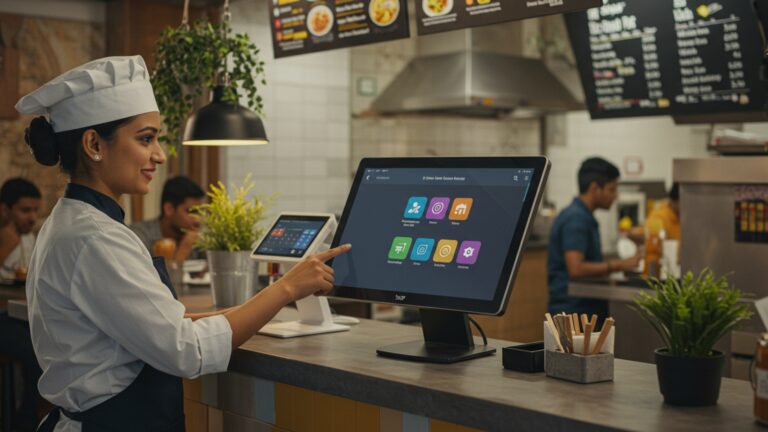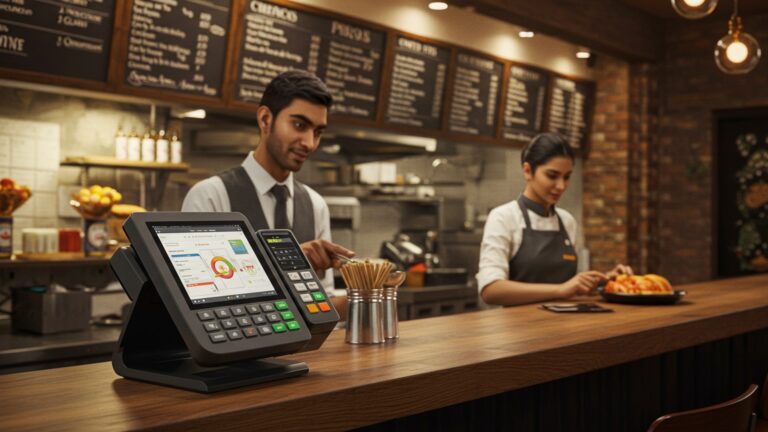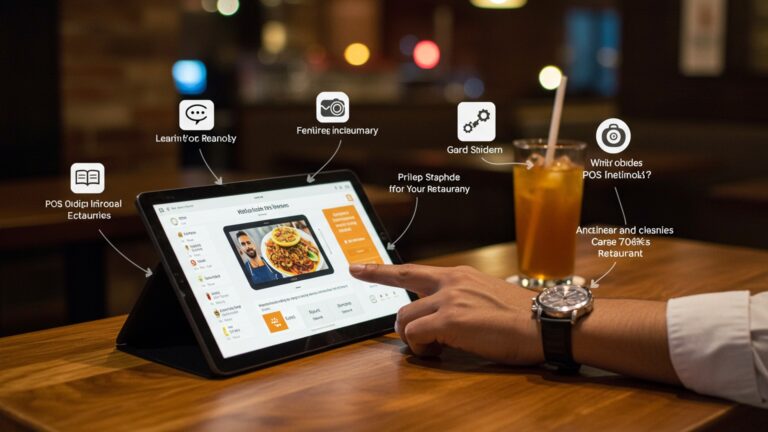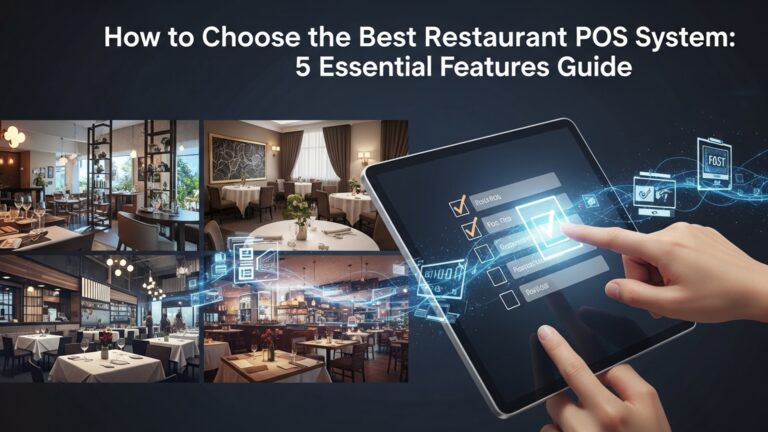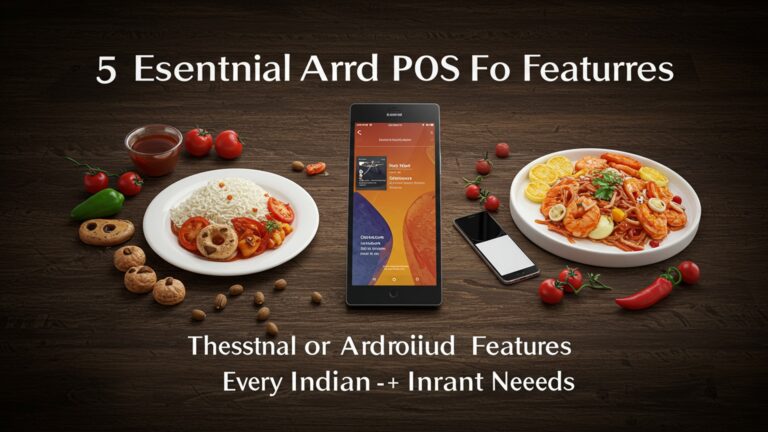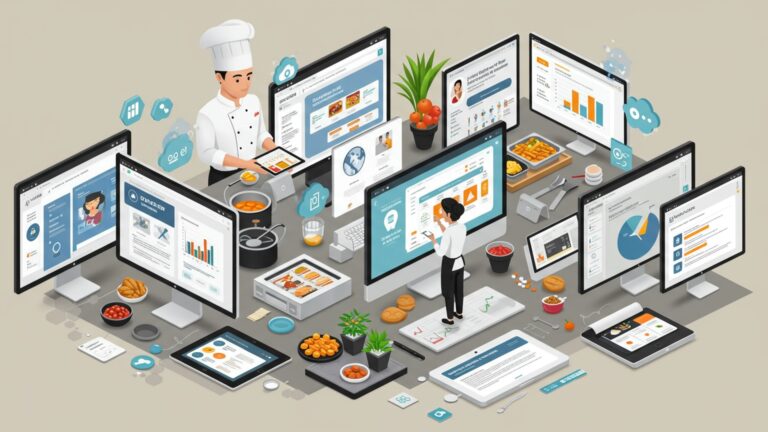How to Pick the Best Restaurant POS System for Small Restaurants India
The vibrant Indian food service sector, particularly for small restaurants, demands more than just traditional billing. With the surge in online delivery platforms like Zomato and Swiggy, coupled with the widespread adoption of UPI payments, a robust Restaurant POS system for small restaurants India is now a critical operational backbone. Operators must navigate options that offer seamless integration, real-time inventory management. intuitive order processing, moving beyond basic transactions to leverage data analytics for smarter purchasing and enhanced customer loyalty. Selecting the ideal cloud-based solution means ensuring it handles peak hours efficiently, manages staff schedules. provides actionable insights, ultimately driving profitability in a fiercely competitive market.

Understanding the Crucial Role of a Restaurant POS System for Small Restaurants India
In the bustling and competitive landscape of India’s food industry, small restaurants, cafes. cloud kitchens often operate on tight margins, making efficiency and cost-effectiveness paramount. A robust Restaurant POS system for small restaurants India is no longer a luxury but a fundamental tool for survival and growth. It’s the central nervous system of your establishment, streamlining operations, improving customer experience. providing crucial insights into your business’s performance. Without a modern POS, small restaurants risk falling behind competitors who leverage technology to manage orders, inventory. customer relationships more effectively. From a quick-service eatery in Delhi to a quaint cafe in Goa, the right POS system can transform how a small restaurant operates, ensuring smoother daily routines and better strategic decisions.
Core Components of a Modern Restaurant POS System
To effectively choose a Restaurant POS system for small restaurants India, it’s essential to interpret its fundamental building blocks. These components work in synergy to create a comprehensive management solution.
- Hardware
- Touchscreen Terminal/Tablet
- Printer
- Cash Drawer
- Card Reader (POS Terminal)
- Barcode Scanner
- Software
- Front-of-House (FOH) Interface
- Back-of-House (BOH) Management
- Network Connectivity
- Internet Connection
- Local Area Network (LAN)
This includes the physical devices that facilitate transactions and operations.
The primary interface for order entry and management. For small restaurants, tablets (like iPads or Android tablets) are popular due to their portability and lower cost.
For KOTs (Kitchen Order Tickets), bill receipts. reports. Thermal printers are common for speed and low maintenance.
A secure place for cash transactions.
For processing debit/credit card payments. Increasingly, integrated payment solutions are preferred.
Useful for inventory management, especially for packaged goods or items with barcodes.
The brains of the operation, dictating functionality.
User-friendly interface for staff to take orders, manage tables. process payments.
Tools for inventory control, menu management, employee scheduling, reporting. customer relationship management (CRM).
How the system communicates.
Essential for cloud-based systems, online orders. payment processing.
Connects devices within the restaurant (e. g. , POS terminal to kitchen display system).
Understanding these components helps small restaurant owners evaluate the overall cost and suitability of a system. For instance, a cloud-based Restaurant POS system for small restaurants India might require less upfront hardware investment but depend heavily on reliable internet.
Key Features to Look for in a Restaurant POS System for Small Restaurants India
When evaluating a Restaurant POS system for small restaurants India, specific features become critical for operational success and growth. Prioritize these functionalities:
- Intuitive User Interface (UI)
- Order Management
- Table Management
- KOT (Kitchen Order Ticket) / KDS (Kitchen Display System)
- Customizable Menu
- Order Modifiers
- Billing & Payments
- Multiple Payment Options
- Bill Splitting & Customization
- GST Compliance
- Inventory Management
- Reporting & Analytics
- Employee Management
- Customer Relationship Management (CRM)
- Online Ordering & Delivery Integration
The system must be easy for staff to learn and use, minimizing training time and errors. A cluttered or complex interface can slow down service, especially during peak hours.
Visual layouts to assign tables, track order status. split bills.
Efficiently send orders to the kitchen, reducing errors and improving speed. KDS is digital, showing orders on a screen in the kitchen, often with timers.
Easily add/remove items, modify prices. apply discounts or combos. This is crucial for seasonal menus or daily specials.
Ability to add special instructions (e. g. , “no onion,” “extra spicy”) to orders.
Support for cash, credit/debit cards, UPI (Google Pay, PhonePe, Paytm). digital wallets. This is non-negotiable in India.
Flexibility to split bills by item or equally. apply discounts or service charges.
Automatically calculate and generate GST-compliant bills and reports, simplifying tax filing.
Track raw materials and finished goods, set reorder points. reduce wastage. For a small restaurant, this can significantly impact profitability.
Provide insights into sales trends, popular dishes, peak hours, employee performance. inventory consumption. This data is invaluable for making informed business decisions.
Track staff attendance, manage shifts. monitor individual sales performance.
Build a customer database, manage loyalty programs. track customer preferences. This helps in targeted marketing and repeat business.
Seamlessly integrate with popular food aggregators (Swiggy, Zomato) and potentially offer your own direct online ordering platform.
A restaurant owner in Bengaluru, running a small South Indian eatery, shared how adopting a POS with robust KOT and inventory features helped them reduce food waste by 15% and improve service speed during lunch rushes, directly impacting their bottom line.
Cloud-Based vs. On-Premise POS: A Critical Comparison for Small Restaurants India
The choice between a cloud-based and an on-premise Restaurant POS system for small restaurants India is fundamental, impacting cost, flexibility. maintenance.
| Feature | Cloud-Based POS | On-Premise POS |
|---|---|---|
| Definition | Software hosted on remote servers, accessed via the internet. Data stored online. | Software installed directly on the restaurant’s local hardware. Data stored locally. |
| Cost Structure | Typically subscription-based (monthly/annual fees). Lower upfront hardware costs. | Higher upfront cost for software license and dedicated hardware. Lower ongoing subscription fees (or none). |
| Accessibility | Access data and manage operations from anywhere with an internet connection (e. g. , on a phone, tablet, or laptop). | Primarily accessible only within the restaurant premises or via complex remote access setups. |
| Maintenance & Updates | Managed by the vendor; automatic updates, backups. security patches. Less burden on the restaurant owner. | Requires local IT expertise for maintenance, updates. backups. Potential for higher IT costs. |
| Scalability | Easily scalable; add more terminals or features as the business grows. | Scaling often requires additional hardware and software licenses, which can be more complex and costly. |
| Security | Vendor responsible for data security, often with robust encryption and backup protocols. Depends on vendor’s reliability. | Restaurant responsible for its own data security. Vulnerable to local hardware failures or breaches if not properly managed. |
| Internet Dependency | Requires a stable internet connection for full functionality. Some offer offline modes with data sync. | Less dependent on internet for core operations. may need it for external integrations (e. g. , online payments). |
| Best For Small Restaurants India | Often preferred due to lower upfront cost, flexibility. minimal IT overhead, especially for new ventures or those with limited tech staff. | Suitable for larger, established restaurants with specific customization needs, high transaction volumes. in-house IT support. Less common for small setups now. |
For most small restaurants in India, a cloud-based Restaurant POS system offers significant advantages in terms of affordability, ease of use. accessibility. Imagine a small cafe owner in Pune who can check daily sales reports from home or update their menu from their mobile phone – that’s the power of cloud POS.
Evaluating Pricing Models: A Practical Approach for Your Restaurant POS system for small restaurants India
The cost of a Restaurant POS system for small restaurants India can vary significantly. Understanding the different pricing models is crucial to avoid hidden charges and choose a system that fits your budget.
- Subscription-Based (SaaS – Software as a Service)
- Pros
- Cons
- Actionable Tip
- Per-Terminal Pricing
- Pros
- Cons
- Actionable Tip
- Transaction-Based Fees
- Pros
- Cons
- Actionable Tip
- One-Time Purchase (On-Premise)
- Pros
- Cons
- Actionable Tip
This is the most common model for cloud POS systems. You pay a recurring monthly or annual fee for using the software.
Lower upfront cost, includes updates and support, scalable.
Ongoing cost, you don’t “own” the software.
Look for tiered pricing plans. A basic plan might cover core POS functions, while higher tiers offer advanced features like extensive CRM or multi-location management. Ensure the basic plan meets your essential needs.
Some vendors charge based on the number of POS terminals or devices you use.
Clear cost per workstation.
Can become expensive if you need multiple terminals for a slightly larger small restaurant.
If your small restaurant only needs one or two terminals, this might be cost-effective. But if you foresee needing more, a flat subscription might be better.
Less common for core POS software but often applies to integrated payment processing. You pay a small percentage or flat fee per transaction.
Only pay when you process sales.
Can add up quickly with high transaction volumes.
Always compare the overall effective rate (including any gateway fees) from different payment processors integrated with the POS.
You buy the software license outright.
No recurring software fees (after initial purchase).
High upfront cost, additional costs for updates, maintenance. support.
Generally not recommended for small restaurants due to the high initial investment and ongoing IT burden.
When comparing prices, always ask for a detailed breakdown of what’s included: hardware, software, installation, training. ongoing support. A seemingly cheap Restaurant POS system for small restaurants India might have hidden costs for essential features or support.
Integration Capabilities: Connecting Your Ecosystem
A truly effective Restaurant POS system for small restaurants India doesn’t operate in isolation. Its ability to integrate with other essential tools and platforms is paramount for holistic management and efficiency.
- Payment Gateways
- Online Food Aggregators
- Accounting Software
- Loyalty & CRM Platforms
- Inventory & Supply Chain Management
Seamless integration with local payment processors (e. g. , Razorpay, PayU, Stripe India) is critical for smooth card and UPI transactions. This reduces manual errors and reconciliations.
For many small restaurants in India, platforms like Swiggy and Zomato are major revenue streams. Integration allows orders from these platforms to flow directly into your POS, preventing missed orders, manual re-entry. improving order accuracy.
Connect your POS to accounting platforms like Tally or Zoho Books. This automates sales data entry, simplifies financial reporting. streamlines tax compliance (especially GST). A cafe owner in Chennai found that integrating their POS with Tally cut their monthly accounting work by half.
If your POS doesn’t have robust in-built CRM, consider integration with third-party loyalty programs to manage customer data, offer rewards. run targeted marketing campaigns.
For more complex operations, integration with advanced inventory systems or supplier portals can automate purchase orders and stock alerts.
When a Restaurant POS system for small restaurants India integrates well, it creates a unified operational ecosystem, eliminating data silos and improving overall business intelligence. Always ask potential vendors about their existing integrations and if they offer open APIs (Application Programming Interfaces) for custom integrations if needed.
// Example of an API call concept for online order integration (simplified)
// This isn't actual code for a POS. illustrates the idea of data exchange. function fetchOnlineOrders(aggregatorAPIKey) { // This function would make an HTTP request to the food aggregator's API // to retrieve new orders. fetch(`https://api. foodaggregator. com/orders? apiKey=${aggregatorAPIKey}&status=new`). then(response => response. json()). then(orders => { orders. forEach(order => { console. log(`New order received: ${order. id} for ${order. customerName}`); // Logic to push order into local POS system processOrderInPOS(order); }); }). catch(error => console. error('Error fetching online orders:', error));
} function processOrderInPOS(orderData) { // This would be internal POS logic to: // 1. Create a new order in the POS database // 2. Print KOTs // 3. Update inventory (if real-time) // 4. Notify kitchen staff console. log(`Processing order ${orderData. id} in POS...`) ; // ... further POS specific operations
} // In a real scenario, this would run periodically or be triggered by webhooks. // fetchOnlineOrders("YOUR_AGGREGATOR_API_KEY");
Considering Local Support and Customization for the Indian Market
Choosing a Restaurant POS system for small restaurants India isn’t just about features; it’s also about the support infrastructure and how well the system adapts to local nuances.
- Local Support
- Availability
- Language
- Response Time
- On-Site Support
- Customization for the Indian Market
- GST Compliance
- Regional Payment Methods
- Menu Localization
- Delivery Partner Integrations
- Accounting Software Compatibility
Does the vendor offer 24/7 or extended hours support, especially during peak restaurant operating times?
Is support available in local Indian languages if required, or at least clear English?
What are the guaranteed response times for critical issues? Downtime can be costly for a small restaurant.
While many issues can be resolved remotely, inquire about the availability of on-site technical support for hardware failures or complex installations, particularly in your city or region. A small eatery in Tier-2 city found that having a local vendor representative was invaluable for quick troubleshooting.
As mentioned, this is non-negotiable. The system must accurately calculate and generate GST-compliant invoices and reports.
Beyond UPI, consider if there are any specific local payment methods or wallet integrations popular in your area.
The ability to display menu items in regional languages (e. g. , Hindi, Marathi, Tamil, Bengali) if your customer base or staff prefers it.
Ensuring seamless integration with major Indian food delivery platforms is crucial.
Integration with popular Indian accounting software like Tally is often a major plus.
Prioritizing a vendor with a strong presence and understanding of the Indian market can save a lot of headaches down the line. They are more likely to offer relevant features, better support. timely updates to comply with local regulations.
Steps to Choosing Your Ideal Restaurant POS System for Small Restaurants India
Navigating the selection process can seem daunting. a structured approach can simplify it. Follow these actionable steps to pick the best Restaurant POS system for small restaurants India:
- Assess Your Specific Needs
- What type of restaurant do you run (cafe, QSR, fine-dine, cloud kitchen)?
- What are your average daily transactions?
- What are your absolute must-have features (e. g. , KDS, inventory, online ordering)?
- What is your budget for both upfront costs and monthly subscriptions?
- How tech-savvy are you and your staff?
- Research Potential Vendors
- Look for vendors specifically catering to the Indian market or those with a strong presence here.
- Read reviews on independent platforms and industry forums.
- Ask other small restaurant owners for recommendations.
- Request Demos and Free Trials
- Schedule personalized demos with your top 2-3 choices. Have a checklist of your must-have features.
- If possible, opt for a free trial. This allows you to test the system in your actual restaurant environment. Pay attention to ease of use, stability. crucial feature performance.
- Involve your key staff in the demo/trial process, as they will be the primary users.
- Evaluate Pricing and Support
- Get a clear, itemized quote for all hardware, software, installation, training. ongoing support.
- grasp the contract terms: Is it monthly, annually? Are there cancellation fees?
- Clarify the support structure: hours, channels (phone, email, chat). response times.
- Check for Scalability and Future-Proofing
- Consider your growth plans. Can the system easily accommodate more terminals, locations, or advanced features as your business expands?
- Does the vendor regularly update their software with new features and security patches?
- Make the Decision
- Based on your evaluation, choose the Restaurant POS system for small restaurants India that best balances features, cost, ease of use. reliable support.
- Negotiate if possible, especially for longer-term commitments.
Remember, the best Restaurant POS system for small restaurants India is one that not only meets your current needs but also supports your future aspirations, helping you grow efficiently and profitably.
Conclusion
Selecting the ideal POS for your small Indian restaurant isn’t merely a transaction; it’s a strategic investment in your future. Remember, the ‘best’ system is the one that seamlessly aligns with your specific operational flow, whether you’re a bustling chai shop handling quick transactions or a cozy family diner managing table service and home delivery. My personal tip? Always insist on a live demo and robust local support – navigating technical glitches in India demands a responsive partner, not just a flashy product. Consider the current landscape: cloud-based systems are no longer a luxury but a necessity, enabling smooth integration with popular online aggregators like Swiggy/Zomato and facilitating quick, secure UPI payments. This forward-thinking approach will not only streamline billing but also unlock valuable insights into your sales and inventory, a critical advantage in today’s competitive market. Your informed decision today empowers you to enhance efficiency, delight customers. ultimately, scale your culinary dream with confidence.
More Articles
10 Factors to Select the Best POS System for Your Indian Restaurant
7 Key Benefits of Cloud POS for Indian Restaurant Growth
5 Essential Android POS Features Every Indian Restaurant Needs
A Guide to 10 Essential Online Ordering POS Systems in India
Uncover the Best POS Software in India for Small Businesses
FAQs
Why should my small Indian restaurant even bother with a POS system?
A good POS isn’t just for big chains! For a small Indian restaurant, it speeds up order taking, manages billing, tracks sales. even helps with inventory. No more fumbling with paper bills or worrying about missed orders. It makes your operations smoother, reduces errors. helps you interpret what’s selling best.
What are the absolute essential features I need in a POS for my place?
Look for core functions like quick order entry (especially for Indian menus with lots of variations), table management, split billing, KOT (Kitchen Order Ticket) printing. integrated payment options. Inventory management, basic reporting. customer management are also super helpful. Don’t forget support for regional languages if your staff needs it!
How much does a decent POS system typically cost for a small restaurant in India?
Prices vary a lot! You can find subscription-based cloud systems starting from a few thousand rupees per month. On-premise systems might have a higher upfront cost but no recurring monthly fees. Factor in hardware (tablet/PC, printer, cash drawer) too. Always ask about hidden costs for setup, training, or ongoing support.
Should I go for a cloud-based or a traditional on-premise POS system?
For most small Indian restaurants, cloud-based is usually better. It’s often cheaper upfront, easier to update. you can access your sales data from anywhere. You don’t need dedicated IT staff. On-premise offers more control and doesn’t rely on internet. it’s generally more expensive and complex to maintain.
Is it vital to find a POS vendor with local support in India?
Absolutely! Local support means faster help when things go wrong. they’ll comprehend the specific challenges and nuances of the Indian market (like different payment methods or GST rules). A vendor with a strong local presence can offer better training and on-site assistance if needed, which is invaluable for a small business.
Can a POS actually help me manage my inventory better and track staff performance?
Yes, a good POS can be a game-changer for both! It tracks ingredients as dishes are sold, helping you avoid waste and stockouts. For staff, it can show who processed which orders, sales per staff member. even clock-in/out times, helping you identify top performers and areas for improvement.
How can I make sure the POS system isn’t too complicated for my staff to learn?
Simplicity is key! Look for a system with an intuitive, user-friendly interface. Ask for a demo and let your staff try it out. A good vendor will offer comprehensive training. Make sure the buttons are clear. the workflow for common tasks (like taking an order or splitting a bill) is straightforward.

